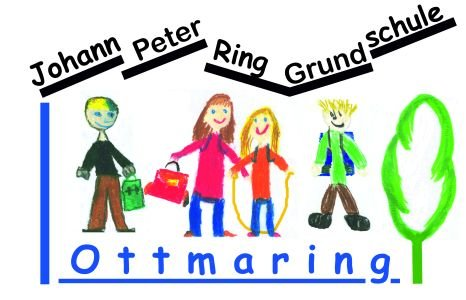The Johann-Peter-Ring-Primary School Ottmaring has been mixed-age since the 2010/2011 school year.
Students from the Friedberg districts of Ottmaring, Rederzhausen, Bachern, Hügelshart and Rohrbach go to our school. Some of our school children are transported by school bus. We currently have eight classes. Four classes are 1/2 mixture and four classes are 3/4. There are four kindergartens in our catchment area with which we cooperate. We have thirteen permanent teachers and four specialist teachers who we share with other schools. Our material expense provider is the city of Friedberg.
"Flexible primary school" in Bavaria - mixed years 1/2"
In the so-called “flexible entry level” of the profile schools, students in grades 1 and 2 learn together in a class group. The number of students in the class is limited to 25 children. The differences between the students are used as an opportunity to learn specifically from and with each other. This means that those starting school receive support from their older classmates right from the start. They, in turn, experience themselves as skilled people, take on shared responsibility and thereby gain self-confidence in their own abilities.
Connection to preschool education and upbringing
The age mix is familiar to those starting school from the situation in daycare centers or families. The flexible elementary school builds on the children's previous experiences and continues the familiar situation of different age groups working and learning together.
Survey of the individual learning starting point
Children begin primary school with different levels of prior knowledge. So that the learning offering can be optimally adapted to the individual learning level, the teachers determine the learning starting point of those starting school. Based on the knowledge gained, each individual child can be supported in a developmentally appropriate manner right from the start.
Individualized learning opportunities
The teaching concept takes the diversity of the children into account. Therefore, common topics and open tasks are offered in the classes of the flexible primary school, which are differentiated and worked on in communicative learning situations. In addition, proven and new teaching methods are used in student-activating learning environments that enable learning at your own pace.
In the flexible primary school, every student should be optimally supported. Every child is given the time they need to build a stable foundation in reading, writing and arithmetic. Depending on the level of learning, the child can spend either one year, two years or three years in the so-called entry level. The children are then in primary school for three years, four years or five years. From a pedagogical point of view, it is about aligning the learning processes as best as possible to the individual learning level.
The flexible primary school has been being tested since the 2010/2011 school year. In 2019, a total of 268 Bavarian primary schools offered the first two grades flexibly. The experiences of the teachers and school management are consistently positive.
Forms of performance assessment
The children learn individually. This requires a changed view of performance. We are therefore testing different and new forms of performance assessment and feedback on learning success. This creates a differentiated picture of the individual structure of technical, methodological and social skills. We replace the interim report with a documented parent interview.
Flexible length of stay
The standard period of attendance at the entrance level (grades 1 and 2) is two school years. Adapted to the students' individual learning and performance abilities, the concept opens up the possibility of a third year of school attendance without having to change classes. This is not counted towards compulsory schooling. Children who progress very quickly in their learning and social development can move up to grade 3 after just one year of schooling. The legal guardians and the school work closely together when deciding on the length of stay.
Educational partnership and design of transitions
The changes in teaching, the increased consideration of individual learning progress and the possibility of a flexible length of stay require more intensive advice from parents. The basis for this is the documented observations of the teachers and the results of the performance assessment. Close cooperation with the daycare centers and with the teachers of the following grades ensures that the transitions are as smooth as possible.
The classes in the flexible elementary school are combined by year group
The teachers initially looked closely - because children have very different prior knowledge, especially at the beginning of primary school. Starting from the question: “What can the child already do?” The individual level of knowledge is taken into account in lessons. There are learning modules that build on each other and are to be worked through by the children one after the other. There are also learning modules that offer the same topic for all children in a class, but set tasks at different levels.
Continuation of the mixed age group in grades 3 and 4
Dealing with diversity
Due to our experiences in the mixed grades 1/2, our children also remain in the mix in grades 3 and 4. We also want to maintain the system of mixed years with its positive effects for our older children. The children continue to strengthen their social skills such as empathy and changing perspectives and often learn in the partner system. They cooperate intensively with each other, including as tutors, and thus take into account the increasing heterogeneity. The idea of inclusion plays a major role for us. Even if the independent acquisition of knowledge becomes more important, especially in the class before transfer. Every child is one of the younger ones for some time and one of the older ones for some time. The larger range of learning requirements within a class community also enables children to take on different roles more easily in levels 3 and 4. In this way we achieve the best possible strengthening of the personality of the children entrusted to us.




